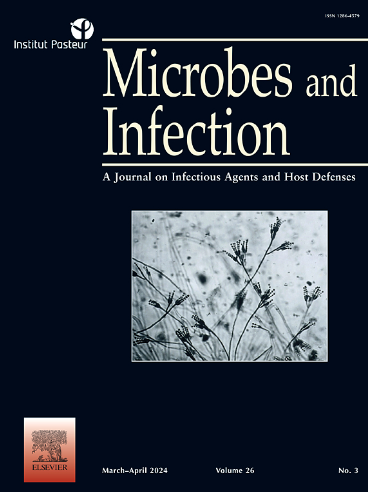Replication-deficient Sendai virus expressing human norovirus capsid protein elicits robust NoV-specific antibody and T-cell responses in mice
IF 2.7
4区 医学
Q3 IMMUNOLOGY
引用次数: 0
Abstract
Human norovirus (HuNoV) is a major global cause of acute gastroenteritis, with vaccine development facing several challenges. Despite years of research, there are currently no licensed vaccines available for controlling HuNoVs. Here, we describe the construction and testing of a replication-deficient Sendai virus (SeV) vector as a potential vaccine candidate against the HuNoV GII.4 genotype. SeV was chosen as the vaccine backbone due to its non-pathogenic nature in humans, its capability for long-term antigen expression in mammalian cells, and its suitability for mucosal administration. By inserting the HuNoV GII.4 capsid gene, VP1, into the SeV genome, we generated a replication-deficient SeV (SeV/dP.VP1) vector. The resultant SeV/dP.VP1 virus were observed to successfully express the inserted NoV VP1 gene upon infection. Inoculating the vaccine into wild-type mice elicited NoV-specific IgG antibodies, along with INF-γ and IL-2-producing T cells, through both intranasal (i.n.) and intramuscular (i.m.) immunization. Furthermore, a significant level of NoV-specific IgA was detected in lung homogenates after i.n. immunization, particularly using a high dose of the viral vector. Additionally, a synergistic effect was observed with heterologous prime-boost regimens using SeV/dP.VP1 and MVA.VP1 vectors, indicating the potential for more robust immune responses when the vaccine design is optimized. Our study demonstrates the potential of a SeV vaccine candidate in eliciting a broad immune response and lays the foundation for further exploration of the SeV vector platform's potential as a HuNoV vaccine. Additionally, the results emphasize the importance of vaccine dosage and administration route, highlighting the need for tailored immunization strategies.
表达人类诺瓦克病毒壳蛋白的复制缺陷型 sentai 病毒可在小鼠体内引起强大的诺瓦克病毒特异性抗体和 T 细胞反应。
人类诺如病毒(HuNoV)是全球急性肠胃炎的主要病因,其疫苗开发面临着诸多挑战。尽管进行了多年的研究,但目前还没有可用于控制 HuNoV 的特许疫苗。在此,我们介绍了一种复制缺陷仙台病毒(SeV)载体的构建和测试情况,该载体是针对 HuNoV GII.4 基因型的潜在候选疫苗。选择 SeV 作为疫苗骨架是因为它对人类无致病性,能在哺乳动物细胞中长期表达抗原,而且适合粘膜给药。通过在 SeV 基因组中插入 HuNoV GII.4 荚膜基因 VP1,我们产生了一种复制缺陷 SeV(SeV/dP.VP1)载体。据观察,由此产生的 SeV/dP.VP1 病毒在感染后能成功表达插入的 NoV VP1 基因。通过鼻内(i.n.)和肌肉注射(i.m.)免疫,将疫苗接种到野生型小鼠体内可激发 NoV 特异性 IgG 抗体以及 INF-γ 和 IL-2 产T细胞。此外,鼻内免疫后,特别是使用高剂量的病毒载体免疫后,在肺匀浆中检测到了大量的NoV特异性IgA。此外,使用 SeV/dP.VP1 和 MVA.VP1 病毒载体的异源素体增强方案还观察到了协同效应,这表明疫苗设计优化后有可能产生更强的免疫反应。我们的研究证明了 SeV 候选疫苗在激发广泛免疫应答方面的潜力,并为进一步探索 SeV 载体平台作为 HuNoV 疫苗的潜力奠定了基础。此外,研究结果还强调了疫苗剂量和给药途径的重要性,突出了定制免疫策略的必要性。
本文章由计算机程序翻译,如有差异,请以英文原文为准。
求助全文
约1分钟内获得全文
求助全文
来源期刊

Microbes and Infection
医学-病毒学
CiteScore
12.60
自引率
1.70%
发文量
90
审稿时长
40 days
期刊介绍:
Microbes and Infection publishes 10 peer-reviewed issues per year in all fields of infection and immunity, covering the different levels of host-microbe interactions, and in particular:
the molecular biology and cell biology of the crosstalk between hosts (human and model organisms) and microbes (viruses, bacteria, parasites and fungi), including molecular virulence and evasion mechanisms.
the immune response to infection, including pathogenesis and host susceptibility.
emerging human infectious diseases.
systems immunology.
molecular epidemiology/genetics of host pathogen interactions.
microbiota and host "interactions".
vaccine development, including novel strategies and adjuvants.
Clinical studies, accounts of clinical trials and biomarker studies in infectious diseases are within the scope of the journal.
Microbes and Infection publishes articles on human pathogens or pathogens of model systems. However, articles on other microbes can be published if they contribute to our understanding of basic mechanisms of host-pathogen interactions. Purely descriptive and preliminary studies are discouraged.
 求助内容:
求助内容: 应助结果提醒方式:
应助结果提醒方式:


